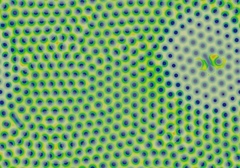August 13, 2011
Can't keep good reactions undiffused
 Robert Munafo has re-done one of my favourite web resources ever, xmorphia. His page Reaction-Diffusion by the Gray-Scott Model: Pearson's Parameterization contains an interactive map of the parameters of a reaction-diffusion system, where you can click and see pictures and animations of the patterns generated by the system. Way cool!
Robert Munafo has re-done one of my favourite web resources ever, xmorphia. His page Reaction-Diffusion by the Gray-Scott Model: Pearson's Parameterization contains an interactive map of the parameters of a reaction-diffusion system, where you can click and see pictures and animations of the patterns generated by the system. Way cool!
For those not in the know, reaction-diffusion systems are models of (bio)chemistry where chemicals react with each other and diffuse on a 2D surface. The classic results by Alan Turing demonstrated that if there are two substances where one inhibits the production of the other and the other helps produce the inhibitor, and they spread out at different rates, then complex patterns will spontaneously form. This kind of self-organisation is closely linked to how many biological patterns emerge. It is easy to get spots, stripes, fingerprint patterns, cell-like structures and even more strange moving patterns.
Xmorphia was an amazing resource when it appeared back in the early 90s, one of the first truly impressive scientific visualisations on the web (see it in the wayback machine). Not only did it have an interactive image-map, but it had movies! Now sadly defunct, it is good to know that it has a worthy successor. The new page also has plenty of references and interesting new results.
(In addition, Jonathan Lidbeck has a java version of the system here)
Posted by Anders3 at August 13, 2011 11:24 AM